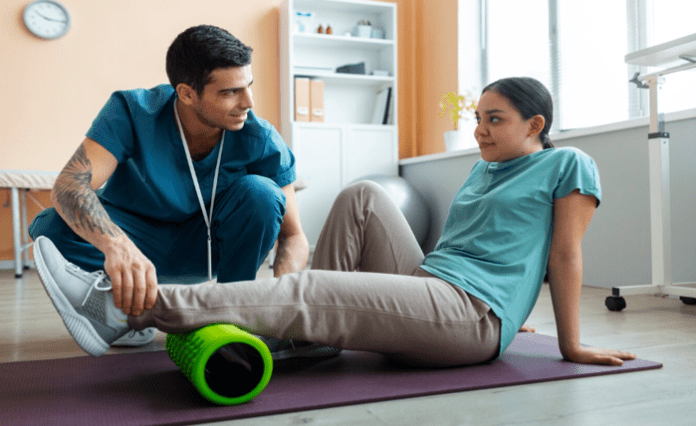Introduction:
Ethan, a 42-year-old accountant from Ottawa, was used to pushing through his workdays with nagging back pain. “It’s just part of sitting all day,” he’d tell himself. His wife, a recreational tennis player, was no stranger to shoulder stiffness either. Like many of us, they didn’t think much of these everyday discomforts—until a simple grocery bag caused Ethan’s back to give out completely.
Stories like Ethan’s are more common than we think. What’s often overlooked is how principles from Sports Therapy in Ottawa—usually associated with elite athletes—can make a profound difference in the lives of regular people. Whether it’s back pain from sitting too long, knee pain from walking, or shoulder discomfort from household chores, these are musculoskeletal issues that respond well to targeted, science-based treatments.
In this article, we’ll explore how physiotherapy in Ottawa, especially sports therapy, isn’t just for Olympians but can be an empowering tool for anyone looking to live pain-free.
-
The Everyday Athlete: You
You might not run marathons or climb mountains, but your body performs athletic movements every day. Walking up stairs, lifting groceries, chasing after your kids, even sitting at a desk for eight hours—each of these activities demands strength, coordination, and flexibility.
- Your body endures repetitive stress whether you’re active or sedentary.
- Micro-injuries occur when muscles or joints are overused or misused.
- Without attention, these minor issues escalate into chronic pain.
Sports therapy recognizes this pattern. It emphasizes early intervention and prevention—two concepts often missing in conventional treatment plans.
-
Understanding Sports Therapy: Science Meets Movement
Sports therapy is a branch of physiotherapy that focuses on:
- Injury prevention
- Rehabilitation after injury
- Performance enhancement
- Long-term musculoskeletal health
Unlike general rehabilitation, sports therapy uses a more dynamic approach, incorporating movement-based assessments, manual therapy, and exercise prescriptions customized to individual needs.
Even if you’re not an athlete, you benefit from:
- Injury prediction models: Understand which of your daily habits may lead to injury.
- Corrective movement therapy: Retrain your body to move efficiently and without pain.
- Performance enhancement techniques: Apply elite strategies to improve strength and mobility in everyday life.
-
Data-Driven Benefits: What the Numbers Say
Numerous studies have validated the use of sports therapy techniques in non-athletic populations.
- A 2020 review in BMJ Open Sport & Exercise Medicine found that exercise-based therapies reduce chronic back pain by up to 60%.
- The Canadian Physiotherapy Association reported that individuals who underwent proactive therapy had 50% fewer musculoskeletal-related doctor visits in the following year.
- In Ottawa Physiotherapy clinics offering physiotherapy and sports therapy, there has been a 30% increase in patients seeking preventative care, indicating growing awareness.
This isn’t about stretching more or using resistance bands. It’s about informed, data-backed strategies that retrain how your body functions.
-
Common Pains and How Sports Therapy Helps
Let’s revisit Ethan. His back pain was the result of years of poor posture and tight hip flexors, compounded by a weak core. His wife’s shoulder stiffness stemmed from repetitive overhead movements with weak rotator cuff muscles.
Here’s how sports therapy in Ottawa addressed their issues:
Back Pain from Prolonged Sitting
- Assessment: Posture, pelvic tilt, and core activation tested.
- Treatment: Manual therapy, core strengthening, and ergonomic training.
- Result: Reduced pain within 3 weeks and improved posture awareness.
Knee Pain from Walking
- Assessment: Gait analysis revealed tight calves and weak glutes.
- Treatment: Mobility drills, glute activation, and proper walking mechanics.
- Result: Pain-free walking and reduced fatigue.
Shoulder Stiffness from Daily Activities
- Assessment: Rotator cuff strength and scapular movement.
- Treatment: Strength training, mobility work, and postural exercises.
- Result: Full range of motion regained with better muscle balance.
These interventions are non-invasive, proactive, and science-based—making them ideal for long-term wellness.
-
Why Prevention is the New Cure
Most people wait until pain becomes unbearable before seeking help. But sports therapy flips this narrative:
- Early Detection: Identifies risk factors before they become injuries.
- Targeted Exercise: Prevents pain through strength and mobility.
- Long-Term Habits: Builds body awareness to reduce future discomfort.
By integrating these practices into everyday life, you’re not just treating symptoms—you’re cultivating resilience.
Quick prevention tips you can apply today:
- Take a standing or movement break every 30–45 minutes at your desk.
- Do five minutes of mobility exercises in the morning.
- Use proper lifting techniques—bend at the hips, not your back.
- Strengthen key muscle groups like glutes, core, and upper back.
-
The Ottawa Perspective: Accessible, Local Solutions
Ottawa has seen a boom in modern physiotherapy clinics that specialize in sports therapy. This reflects a broader trend of accessible, patient-centered care that empowers individuals rather than making them dependent on long-term treatments.
Physiocare Physiotherapy & Rehab Centre is one such example, offering personalized plans that combine manual therapy, rehabilitation science, and preventive care. Their approach doesn’t just treat the pain—it addresses the why behind the pain.
Whether you’re a desk worker, a senior, or a weekend warrior, you deserve high-quality care that understands your needs.
Conclusion:
You don’t have to be an athlete to benefit from sports therapy in Ottawa. Every step you take, every time you sit or reach, your body is engaging in performance. And like any performer, it thrives with training, recovery, and thoughtful care.
By understanding the proactive principles of sports therapy, you’re not just reacting to pain—you’re preventing it, managing it, and reclaiming your physical freedom.
So next time you feel that twinge in your back or stiffness in your shoulder, don’t shrug it off. It’s your body’s way of asking for support. And now, you know how to respond.


